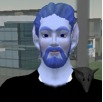Get a MUVE on
Get a MUVE on

Head for the Edge, Library Media Connection, October 2007
Ever wanted to fly? Wear a size 3 dress? Have a beach home? Live as the opposite sex for a while? Change your hairstyle every five minutes? Visit with vampires? Use magical commands to create objects of any shape or form?
Those who have wandered into the online world of Second Life know all these things are possible - and more.
Second Life is one of a number of Multi-User Virtual Environments (MUVEs) that a growing number of adults and children are using for recreation, business and education. In a MUVE you see a graphic representation of yourself walking about a computer-generated world that looks realistic. There you can see, interact and communicate (via chat) with other MUVE users. One can own real estate, purchase items and even start a business. A list of MUVEs, along with their descriptions, can be found at TechSoup <www.techsoup.org/learningcenter/internet/page6759.cfm>.
The best way to learn about Second Life or similar environments may be to just jump in. While there is no cost to participate at a basic level, your experience will be better with a fast computer and good Internet connection. Go to <secondlife.com>, download the client software for your computer, create an account, and login.
Once you are in the world, you will start by creating an avatar, your pictorial representative in Second Life. Read the introductory guides and then stroll or fly about. For those of us who like our information in print, there is Second Life: Official Guide (Sybex, 2006), but there is a complete “Knowledge Base” on the Second Life website.
One of the best ways to get a friendly introduction to this strange new world is by making a friend who is willing to give you a tour and answer your questions. At the time of this writing, ISTE hosts a social on Thursday evenings at 6PM Pacific Coast Time (also Second Life Time) at the ISTE Skypark. Most locations are easily found by using the search engine built into the program and then “teleporting” to that location.
While there is a large commercial (and adult) presence in Second Life, educators are beginning to take advantage of the medium as well:
What excites me the most is that MUVEs may be one of the most powerful tools students can use to create models of people, buildings and landscapes. Second Life just may be the ultimate tinker toy set. Mike Eisenburg envisions that the outcome of a student history research assignment might one day be a virtual museum exhibit - a room in which are gathered photos, documents, analysis of the subject. If the student’s display is considered worthy, it would become a permanent exhibit in this virtual museum. How cool would that be?
But with the tools in Second Life, one need not be limited to a single room. Why not let a class build the museum itself? Or recreate Peter the Great’s Hermitage? Or build Rosa Park’s bus and populate it with avatars that reflect the points of view of the era? Design eco-systems in biology or amusement park rides in physics? Build Huck Finn’s raft or Well’s time machine for lit class?
Be warned. Second Life is at the same stage of development that web browsers were when you first saw them – slow and undependable. Learning this world and how to build in it has a steep learning curve. The seamy side of Second Life is never far from the surface. But the environment improves daily and a separate area just for teens is available.
Lisa Perez, Library Area Coordinator for the Chicago Public Schools (Elaine Tulip in Second Life) and a pioneer in using Second Life as an educational tool, writes:
So, grab your avatar and get a MUVE on. Say hello to BlueSkunk Johnson if you see him!
Head for the Edge, Library Media Connection, October 2007
Ever wanted to fly? Wear a size 3 dress? Have a beach home? Live as the opposite sex for a while? Change your hairstyle every five minutes? Visit with vampires? Use magical commands to create objects of any shape or form?
Those who have wandered into the online world of Second Life know all these things are possible - and more.
Second Life is one of a number of Multi-User Virtual Environments (MUVEs) that a growing number of adults and children are using for recreation, business and education. In a MUVE you see a graphic representation of yourself walking about a computer-generated world that looks realistic. There you can see, interact and communicate (via chat) with other MUVE users. One can own real estate, purchase items and even start a business. A list of MUVEs, along with their descriptions, can be found at TechSoup <www.techsoup.org/learningcenter/internet/page6759.cfm>.
The best way to learn about Second Life or similar environments may be to just jump in. While there is no cost to participate at a basic level, your experience will be better with a fast computer and good Internet connection. Go to <secondlife.com>, download the client software for your computer, create an account, and login.
Once you are in the world, you will start by creating an avatar, your pictorial representative in Second Life. Read the introductory guides and then stroll or fly about. For those of us who like our information in print, there is Second Life: Official Guide (Sybex, 2006), but there is a complete “Knowledge Base” on the Second Life website.
One of the best ways to get a friendly introduction to this strange new world is by making a friend who is willing to give you a tour and answer your questions. At the time of this writing, ISTE hosts a social on Thursday evenings at 6PM Pacific Coast Time (also Second Life Time) at the ISTE Skypark. Most locations are easily found by using the search engine built into the program and then “teleporting” to that location.
While there is a large commercial (and adult) presence in Second Life, educators are beginning to take advantage of the medium as well:
- Professional associations like ALA and ISTE are using the world to offer seminars, forums, and social events. Hear experts and chat your colleagues.
- Teachers are conducting online classes where their avatar works with the avatars of their students, using chat and multimedia support materials.
- Libraries are recreating their images in Second Life. Check the InfoIsland blog <www.infoisland.org> for the latest happenings in virtual library land.
What excites me the most is that MUVEs may be one of the most powerful tools students can use to create models of people, buildings and landscapes. Second Life just may be the ultimate tinker toy set. Mike Eisenburg envisions that the outcome of a student history research assignment might one day be a virtual museum exhibit - a room in which are gathered photos, documents, analysis of the subject. If the student’s display is considered worthy, it would become a permanent exhibit in this virtual museum. How cool would that be?
But with the tools in Second Life, one need not be limited to a single room. Why not let a class build the museum itself? Or recreate Peter the Great’s Hermitage? Or build Rosa Park’s bus and populate it with avatars that reflect the points of view of the era? Design eco-systems in biology or amusement park rides in physics? Build Huck Finn’s raft or Well’s time machine for lit class?
Be warned. Second Life is at the same stage of development that web browsers were when you first saw them – slow and undependable. Learning this world and how to build in it has a steep learning curve. The seamy side of Second Life is never far from the surface. But the environment improves daily and a separate area just for teens is available.
Lisa Perez, Library Area Coordinator for the Chicago Public Schools (Elaine Tulip in Second Life) and a pioneer in using Second Life as an educational tool, writes:
Multi-user virtual reality environments (MUVEs) will continue to expand and evolve, playing a major role in the future of the Internet. Our students are already using MUVEs for entertainment and social networking. Although there are issues that emerge with the growing pains of any new technology, virtual reality environments provide a compelling approach to learning, collaborating, and creating new knowledge.These three dimensional worlds may well be the next incarnation of our interface with information and others online. Gartner Group predicts 80% of all Internet users will be using a form of MUVE by 2011.
So, grab your avatar and get a MUVE on. Say hello to BlueSkunk Johnson if you see him!
Posted on Friday, May 9, 2008 at 02:35PM
by
 Doug Johnson
in Head for the Edge column
|
Doug Johnson
in Head for the Edge column
|
 Post a Comment
Post a Comment





Reader Comments